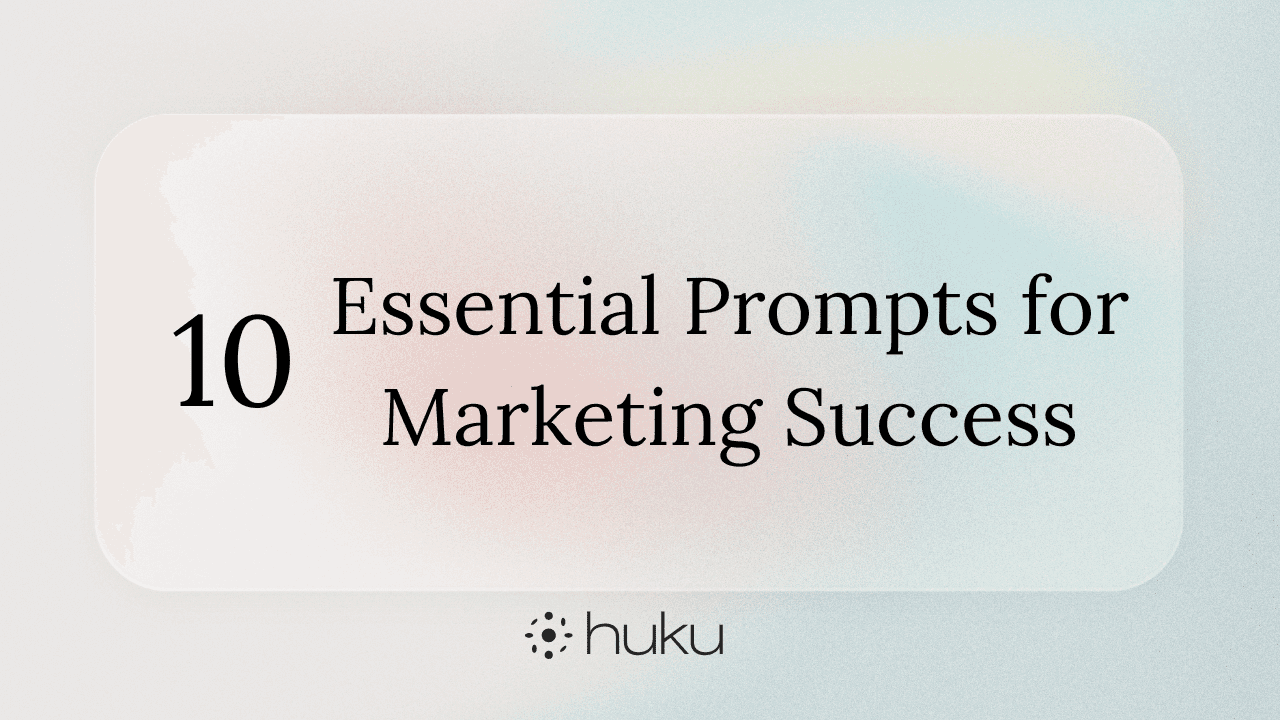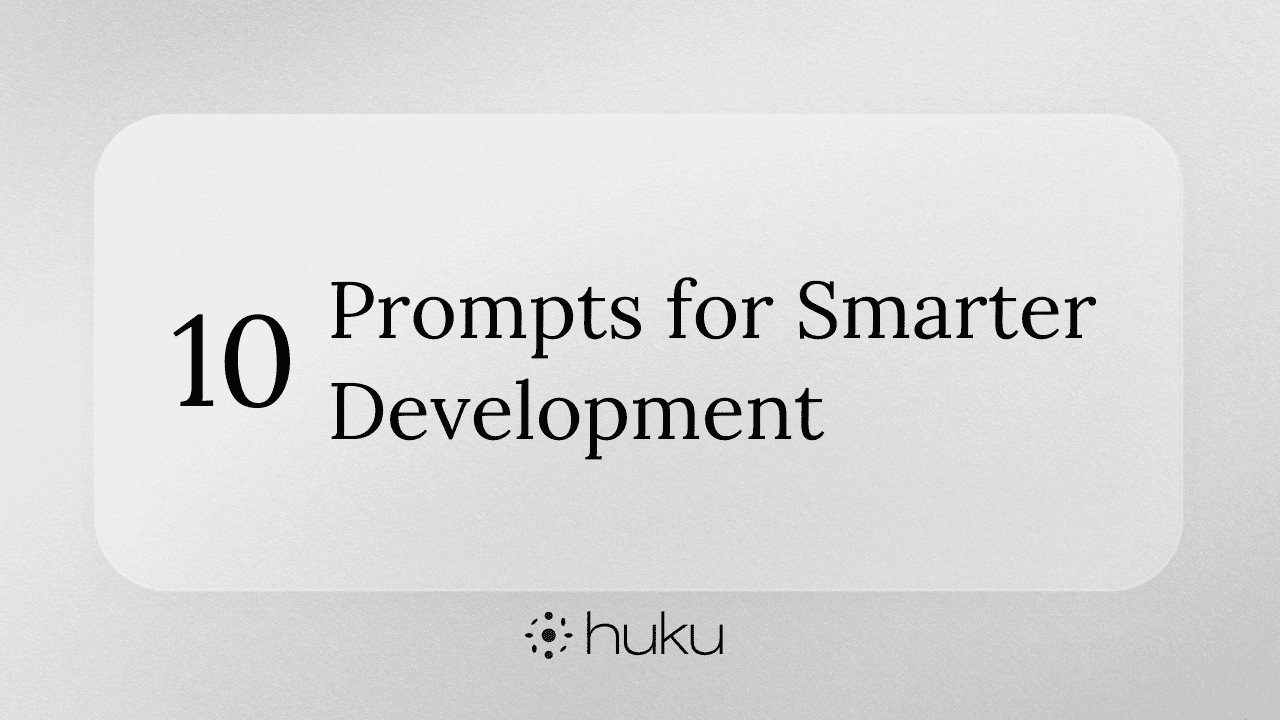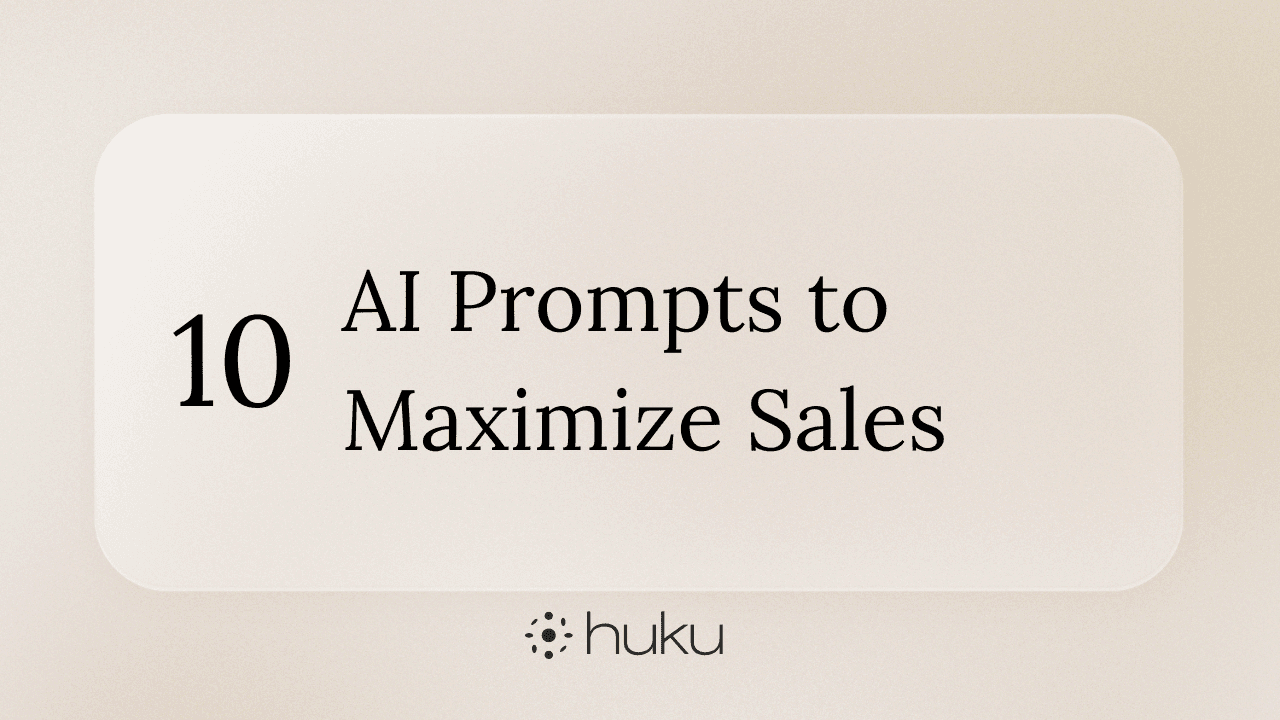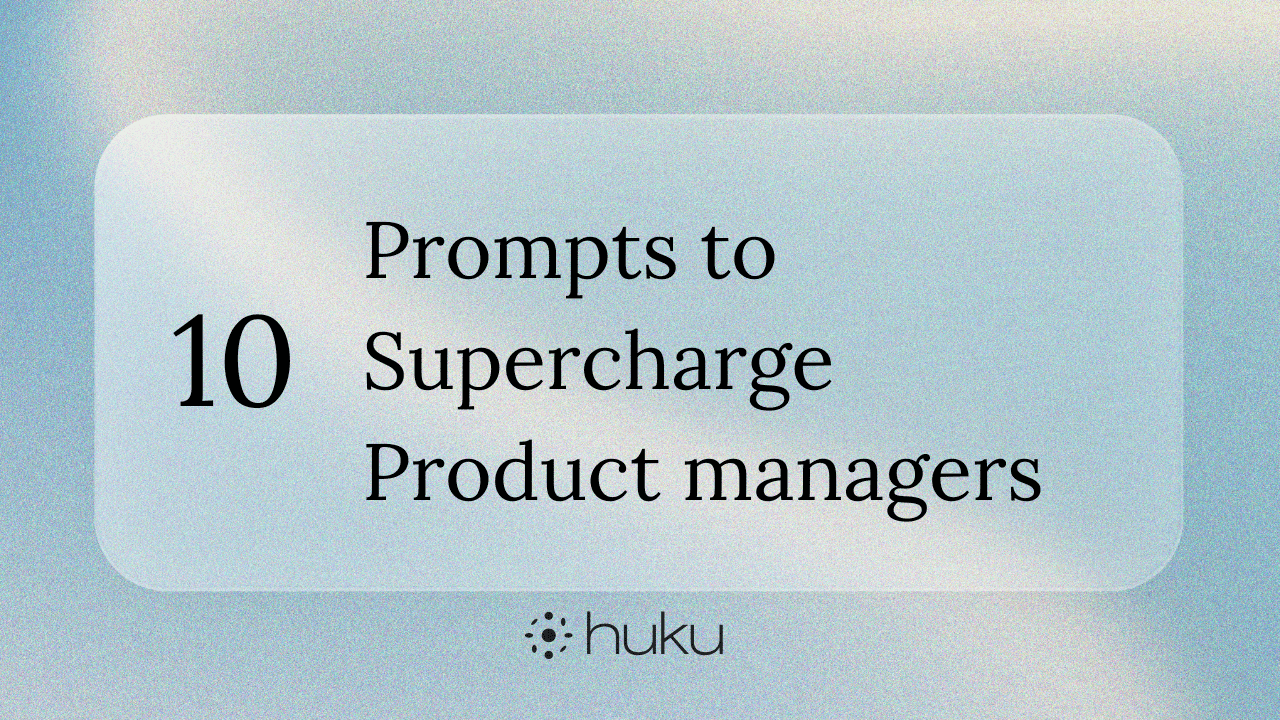AI Applications
40 Essential AI Prompts to Transform Your Work: The Ultimate Guide for Teams
Author
Nov 26, 2024
Introduction
In today's fast-paced work environment, professionals across different roles face similar challenges: mounting tasks, complex decisions, and the constant pressure to deliver better results. While AI has become a buzzword, few teams are leveraging it strategically to enhance their workflow.This comprehensive guide brings together 40 battle-tested AI prompts that are transforming how teams work across product management, engineering, marketing, and sales. These aren't theoretical concepts – they're practical tools that have been refined through real-world applications.
Real Solutions, Not Just Theory
"Oh great, another AI guide," you might be thinking. But stick with me here, because this is different. Instead of vague advice like "use AI to improve productivity" (thanks, but how?), we're diving into specific prompts that solve real workplace headaches. Want to turn messy customer feedback into actionable insights? Got it. Need to debug code that's making you question your life choices? Covered. Looking to write content that doesn't sound like it was created by, well, AI? We've got that too.
Each prompt in this guide comes from real teams solving real problems. We've tested these across hundreds of scenarios, refined them through trial and error, and included examples that show exactly how to adapt them for your needs.
The Power of AI in Modern Work
Before diving into specific prompts, let's understand why AI has become indispensable:
Accelerates decision-making through rapid data analysis
Reduces bias in research and prioritization
Enables consistent documentation and communication
Frees up time for strategic thinking and creativity
Enhances cross-functional collaboration
40 Game-Changing AI Prompts
Product Management Prompts

1. Market Analysis
Prompt: "Analyze current market trends in [industry] over the past [timeframe]. Include: 1) Top 3 emerging opportunities with supporting data, 2) Major threats and market risks, 3) Key technological shifts, and 4) Changes in customer behavior patterns. Format with clear headings and bullet points."
Example: "Analyze the AI-powered design tool market over the past 6 months, focusing on enterprise adoption patterns and integration capabilities."
2. Customer Feedback Synthesis
Prompt: "Review customer feedback from [specific sources] and create a detailed analysis that: 1) Identifies top 5 recurring pain points with frequency data, 2) Lists feature requests ranked by user impact and implementation effort, 3) Highlights positive feedback patterns, and 4) Suggests actionable improvements based on sentiment analysis. Categorize findings by user segment and priority level."
Example: "Analyze last quarter's NPS responses, support tickets, and user interviews for our mobile app, focusing on premium user segment."
3. Feature Prioritization
Prompt: "Evaluate these proposed features [list features] considering: 1) Potential impact on user satisfaction (1-10 scale), 2) Technical implementation complexity, 3) Resource requirements, 4) Expected ROI, and 5) Strategic alignment with our product vision. Provide a prioritized list with justification for each ranking and suggested implementation timeline."
Example: "Evaluate these features for our productivity app: AI task categorization, team analytics dashboard, and calendar integration."
4. Competitive Analysis
Prompt: "Compare our [product/service] with top 3 competitors analyzing: 1) Core features and capabilities, 2) Pricing structures and value propositions, 3) User experience and interface design, 4) Market positioning and messaging, and 5) Customer service approach. Present findings in a comparison matrix format."
Example: "Compare our project management tool with Asana, ClickUp, and Monday.com, focusing on enterprise features and AI capabilities."
5. User Persona Development
Prompt: "Create detailed user personas based on our target demographics, including: 1) Professional background and daily responsibilities, 2) Key challenges and pain points, 3) Technology preferences and usage patterns, 4) Decision-making factors, 5) Goals and success metrics, and 6) Preferred communication channels. Include specific scenarios showing how each persona interacts with our product."
Example: "Create personas for remote team managers using our collaboration platform."
6. Product Roadmap Planning
Prompt: "Generate a strategic product roadmap for the next [timeframe] that includes: 1) Major releases and feature launches, 2) Technical infrastructure updates, 3) Research and discovery phases, 4) Key dependencies and milestones, and 5) Resource allocation recommendations. Structure this in quarters with clear success metrics for each phase."
Example: "Create a 12-month roadmap for our AI-powered analytics platform, focusing on enterprise scalability."
7. Risk Assessment
Prompt: "Analyze potential risks for [product initiative] considering: 1) Market risks, 2) Technical vulnerabilities, 3) User adoption challenges, 4) Competitive threats, and 5) Resource constraints. For each identified risk, provide: Impact severity (1-5), Probability (1-5), Specific mitigation strategies, and Contingency plans."
Example: "Assess risks for our upcoming mobile app launch, focusing on user privacy and performance scalability."
8. Success Metrics Framework
Prompt: "Design a comprehensive metrics framework for [product/feature] that includes: 1) Key performance indicators, 2) User engagement metrics, 3) Business impact measurements, 4) Quality indicators, and 5) Long-term success criteria. Include baseline targets and measurement methodologies."
Example: "Create a metrics framework for our new AI-powered content recommendation engine."
9. Product Specification
Prompt: "Create a detailed product specification for [feature] including: 1) User stories and acceptance criteria, 2) Technical requirements and constraints, 3) UI/UX guidelines, 4) Integration requirements, 5) Performance criteria, and 6) Success metrics. Format as a comprehensive yet scannable document."
Example: "Write a product spec for our new team collaboration dashboard, focusing on real-time data visualization."
10. User Research Plan
Prompt: "Design a user research plan for [specific objective] including: 1) Research goals and questions, 2) Methodology selection and justification, 3) Participant criteria and recruitment strategy, 4) Testing scripts and scenarios, and 5) Analysis framework. Include timeline and resource requirements."
Example: "Create a research plan to evaluate the usability of our new onboarding flow."
Engineering Prompts

11. Code Review
Prompt: "Review this code [insert code] and analyze: 1) Performance bottlenecks, 2) Memory usage, 3) Error handling, 4) Code organization, and 5) Security vulnerabilities. For each issue found, explain why it's problematic, provide a specific fix, and highlight potential edge cases to consider."
Example: "Review our new user authentication service focusing on OAuth2 implementation and rate limiting."
12. Architecture Design
Prompt: "Design a system architecture for [specific application] that handles [X] requests per second. Address: 1) Infrastructure requirements, 2) Component breakdown, 3) Integration points, 4) Scaling strategy, and 5) Security considerations. Include tradeoffs for each major decision and estimated costs."
Example: "Design a microservices architecture for an e-commerce platform handling 50,000 concurrent users during peak hours."
13. API Documentation
Prompt: "Create detailed API documentation for [endpoint/service]. Include: 1) Endpoint specifications, 2) Request/response schemas, 3) Authentication requirements, 4) Rate limiting details, 5) Example requests in curl and [specific language], and 6) Error scenarios and handling guidelines."
Example: "Document our payment processing API endpoints, including webhook integrations and error handling."
14. Test Case Generation
Prompt: "Generate comprehensive test cases for [component] including: 1) Unit tests for core functions, 2) Integration test scenarios, 3) Edge cases and error conditions, 4) Performance test cases, and 5) Security test scenarios. Provide setup requirements and mock data examples."
Example: "Create test suite for our data transformation pipeline, including edge cases for different file formats."
15. Performance Optimization
Prompt: "Analyze performance for [component/process] considering: 1) Time complexity, 2) Memory usage patterns, 3) Network calls optimization, 4) Database query efficiency, and 5) Resource utilization. Provide specific optimization recommendations with expected improvements and implementation approaches."
Example: "Optimize the search functionality in our document management system, focusing on large dataset performance."
16. Security Review
Prompt: "Perform a security audit of [component] checking for: 1) Common vulnerabilities (OWASP Top 10), 2) Authentication/Authorization flaws, 3) Data protection concerns, 4) API security risks, and 5) Dependency vulnerabilities. Provide mitigation strategies and implementation priority for each finding."
Example: "Review security for our file upload service handling sensitive documents, including encryption and access control."
17. Development Environment Setup
Prompt: "Create a development environment setup guide for [specific stack] including: 1) Required tools and versions, 2) Configuration files, 3) Environment variables, 4) Common issues and solutions, 5) Local testing setup, and 6) Debugging tools configuration. Make it beginner-friendly with troubleshooting tips."
Example: "Create setup guide for our React Native project with custom native modules and CI/CD integration."
18. CI/CD Pipeline Design
Prompt: "Design a CI/CD pipeline for [project type] covering: 1) Build stages and dependencies, 2) Test automation strategy, 3) Security scanning integration, 4) Deployment strategies (including rollback), and 5) Monitoring setup. Include configuration files and environment requirements."
Example: "Create a CI/CD pipeline for our microservices architecture using GitHub Actions and AWS."
19. Technical Debt Assessment
Prompt: "Analyze technical debt in [codebase/system] considering: 1) Code quality issues, 2) Outdated dependencies, 3) Architecture limitations, 4) Performance bottlenecks, and 5) Testing gaps. Provide a prioritized remediation plan with effort estimates and risk assessment for each item."
Example: "Assess technical debt in our 3-year-old payment processing service, focusing on scalability and maintainability."
20. System Monitoring Design
Prompt: "Design a monitoring solution for [system] that includes: 1) Key metrics to track, 2) Alerting thresholds and rules, 3) Logging strategy, 4) Dashboard layouts, and 5) Incident response procedures. Consider both technical and business metrics."
Example: "Create a monitoring strategy for our distributed data processing pipeline, including data quality metrics."
Marketing Prompts

21. Content Creation Strategy
Prompt: "Create engaging content strategy for [target audience] addressing [specific pain point]. Include: 1) Content themes and topics, 2) Channel-specific formats, 3) Distribution timeline, 4) SEO optimization guidelines, and 5) Success metrics. Provide content calendar for the next [timeframe]."
Example: "Design a B2B content strategy for our AI platform targeting CTOs, focusing on enterprise digital transformation."
22. Campaign Performance Analysis
Prompt: "Analyze [campaign] performance focusing on: 1) KPI achievement rates, 2) Conversion pathway analysis, 3) Audience response patterns, 4) Cost efficiency metrics, and 5) Optimization opportunities. Compare against [benchmark] and provide actionable recommendations with projected impact."
Example: "Analyze our Q4 email nurture campaign performance, focusing on MQL conversion rates across different industries."
23. Social Media Content Calendar
Prompt: "Create a 2-week social media content calendar for [platform] targeting [audience]. Include: 1) Daily themes, 2) Content mix (edu:entertainment:promotion 70:20:10), 3) Trending topic integration, 4) Platform-specific engagement hooks, and 5) Visual content guidelines. Maintain brand voice while maximizing engagement."
Example: "Design LinkedIn content calendar for our SaaS product, focusing on thought leadership and product updates."
24. Email Sequence Design
Prompt: "Design a [X]-part email sequence for [customer segment] that nurtures [specific goal]. Include: 1) Subject line variations, 2) Personalization elements, 3) Segment-specific pain points and solutions, 4) Progressive CTAs, and 5) A/B testing variables. Provide timing recommendations and success metrics."
Example: "Create a 5-part onboarding email sequence for new enterprise customers, focusing on feature adoption."
25. Ad Copy Generation
Prompt: "Generate ad copy variants for [platform] campaign targeting [audience]. Deliver: 1) 5 headlines, 2) 5 primary text versions, 3) 3 CTA options, 4) 3 description variations, and 5) Responsive ad combinations. Focus on [specific value proposition] and comply with [platform] guidelines."
Example: "Create Google Ads variants for our project management tool, emphasizing AI-powered automation features."
26. Landing Page Optimization
Prompt: "Design landing page content for [product/service] targeting [audience]. Structure: 1) Above-fold hook, 2) Problem-solution framework, 3) Social proof elements, 4) FAQs addressing common objections, 5) Multi-level CTAs, and 6) Trust indicators. Include mobile optimization recommendations."
Example: "Optimize our webinar landing page for senior HR professionals, focusing on AI recruitment solutions."
27. SEO Content Optimization
Prompt: "Optimize [content piece] for [target keyword] while maintaining readability. Include: 1) Header hierarchy, 2) Semantic keyword opportunities, 3) Internal linking suggestions, 4) Meta elements, 5) Featured snippet potential, and 6) Content gap analysis compared to top-ranking pages."
Example: "Optimize our guide on 'enterprise AI implementation' for search, focusing on technical decision-makers."
28. Marketing Analytics Dashboard
Prompt: "Design a marketing dashboard for [stakeholder] showing: 1) Key performance metrics, 2) Campaign ROI tracking, 3) Customer journey insights, 4) Channel performance comparison, and 5) Predictive trends. Include data visualization recommendations and refresh frequency."
Example: "Create an executive dashboard showing multi-channel campaign performance and customer acquisition metrics."
29. Competitor Marketing Analysis
Prompt: "Analyze marketing strategies of [top 3 competitors] examining: 1) Content themes and formats, 2) Channel presence and engagement, 3) Paid advertising approaches, 4) Value propositions, and 5) Target audience engagement. Identify gaps and opportunities for differentiation."
Example: "Analyze content marketing strategies of top 3 competitors in the DevOps tools market."
30. Customer Persona Content Mapping
Prompt: "Create a content mapping strategy for [persona] across their buying journey. Include: 1) Pain points at each stage, 2) Content types and formats, 3) Distribution channels, 4) Engagement triggers, and 5) Conversion optimization opportunities. Align with overall marketing objectives."
Example: "Map content journey for startup founders evaluating our financial management platform."
Sales Prompts

31. Personalized Outreach
Prompt: "Create a personalized outreach sequence for [prospect name/title] at [company], incorporating: 1) Recent company news or achievements, 2) Industry-specific pain points, 3) Relevant case studies or social proof, 4) Clear value proposition, and 5) Multi-channel touchpoints. Use a professional yet conversational tone with an engagement score of 8/10."
Example: "Design outreach sequence for CTO of a fast-growing fintech startup that recently raised Series B funding."
32. Deal Risk Assessment
Prompt: "Analyze risk factors for [specific opportunity] considering: 1) Budget alignment, 2) Decision-maker engagement, 3) Competitive presence, 4) Timeline sensitivity, and 5) Technical requirements fit. Provide risk score (1-10) and mitigation strategies for each factor identified."
Example: "Assess deal risks for $500K enterprise contract with focus on stakeholder buy-in and implementation timeline."
33. Competitive Battle Card
Prompt: "Create a battle card for competing against [competitor] including: 1) Their key strengths and weaknesses, 2) Common objections and responses, 3) Feature comparison matrix, 4) Pricing strategy differences, and 5) Win/loss patterns. Structure for quick reference during sales calls."
Example: "Develop battle card for competing against Salesforce in the mid-market CRM segment."
34. ROI Calculator Script
Prompt: "Design an ROI discussion framework for [product/service] that includes: 1) Key cost factors, 2) Benefit calculations, 3) Timeline projections, 4) Industry benchmarks, and 5) Risk considerations. Include qualifying questions and handling of common objections."
Example: "Create ROI framework for our AI-powered customer service platform, focusing on cost reduction and efficiency gains."
35. Sales Meeting Preparation
Prompt: "Generate a meeting prep guide for [prospect meeting] including: 1) Company research highlights, 2) Attendee backgrounds and interests, 3) Industry trend relevance, 4) Potential pain points, and 5) Success story alignment. Include specific questions and discussion triggers."
Example: "Prepare for C-level meeting with healthcare provider exploring our data analytics solution."
36. Proposal Template Customization
Prompt: "Customize our proposal template for [prospect] incorporating: 1) Specific use cases, 2) Success metrics, 3) Implementation timeline, 4) Resource requirements, and 5) Risk mitigation strategies. Maintain balance between technical detail and business value."
Example: "Customize enterprise proposal for implementing our secure file sharing solution in a financial services firm."
37. Objection Handling Library
Prompt: "Create response frameworks for [common objection category] including: 1) Understanding questions, 2) Value reframing approaches, 3) Social proof examples, 4) ROI justification, and 5) Next step suggestions. Format for different communication channels (email, call, meeting)."
Example: "Develop responses for security-related objections in enterprise SaaS sales."
38. Account Growth Strategy
Prompt: "Design expansion strategy for [existing account] analyzing: 1) Current product usage, 2) Untapped departments/users, 3) Additional use cases, 4) Budget cycles, and 5) Decision-maker mapping. Provide timeline and incremental revenue projections."
Example: "Create growth plan for expanding our collaboration tool usage across all departments of a 5000-employee company."
39. Sales Territory Planning
Prompt: "Generate territory plan for [region/segment] including: 1) Account prioritization framework, 2) Outreach cadence, 3) Resource allocation, 4) Target metrics, and 5) Market opportunity analysis. Factor in seasonal variations and industry-specific buying cycles."
Example: "Design territory plan for East Coast enterprise accounts in manufacturing sector."
40. Win/Loss Analysis
Prompt: "Analyze recent [wins/losses] to identify: 1) Decision factors, 2) Sales process effectiveness, 3) Competitive dynamics, 4) Solution fit, and 5) Relationship strength. Provide specific recommendations for process improvement and win rate optimization."
Example: "Review Q3 enterprise deals (won and lost) to identify patterns and optimization opportunities."
Best Practices for AI Prompt Crafting
Be Incredibly Specific
Provide detailed context- include relevant constraint and specify desired output format
Start Small and Iterate
Test prompts on smaller projects first - Refine based on results and scale what works
Maintain Consistency
Use standard formatting - Keep brand guidelines handy & document successful patterns
Validate Outputs
Cross-reference with data - Test against known scenarios & get peer review when needed
Focus on Value
Align prompts with business objectives - Measure impact & Iterate based on results
Conclusion
AI isn't here to replace human expertise – it's here to augment it. These prompts are your starting point for working smarter, not harder. Start with the prompts that address your biggest challenges, and build from there.
Remember, the best work still comes from understanding your objectives and collaborating effectively. AI just helps us do it more efficiently and consistently.
Next Steps
Choose 2-3 prompts most relevant to your current challenges
Test them in your workflow
Measure results and refine as needed
Gradually incorporate more prompts as you become comfortable
About Huku
Huku is all-in-one AI workspace where teams connect their tools, leverage top AI models, and integrate their knowledge to amplify productivity and tackle complex projects. Our goal is to augment knowledge workers with human-centric AI experiences that accelerate Human + AI collaboration by automating 80% of repetitive tasks and elevating 20% of strategic work by 10x.
















